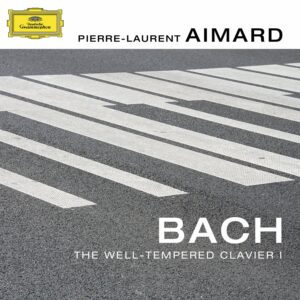While Pierre-Laurent Aimard interprets certain areas of 20th- and 21st-century repertoire with incandescent mastery (Ives, Carter, Messiaen, Ligeti, and Boulez, for example) he’s unpredictable in earlier music. His Bach is a case in point. Reviewing Aimard’s DG The Art of Fugue I wrote how the pianist’s earnest and forceful approach generally seemed more attuned to the music’s inherent rigor and pedagogical premise than to its expressive character. Likewise, his Well-Tempered Clavier Book I alternates between pedantic and persuasive.
Compare, for instance, Aimard’s rigidly-phrased detached notes in the C major and C minor Fugues to Angela Hewitt’s dancing delicacy, or contrast his flat-footed C-sharp major Fugue with Vladimir Ashkenazy’s quicker, suppler version. Aimard’s reserved yet relaxed C-sharp minor Prelude leads into a fluid, thoughtfully organized five-voice fugue. Aimard’s detached bass notes in the D minor Prelude generate welcome tension and release, as do his ever-so-slight accelerations, in contrast to the prosaic fugue. Lovely phrase shaping alternates with overly emphatic articulation in the E-flat major Prelude, while the Fugue’s accented downbeats suggest a schoolmaster beating time with a stick. Yet Aimard’s intelligent dynamic gradations and rapturous tonal shadings in the E-flat minor Prelude continue to reveal new details after many rehearings.
Aimard begins the G minor Prelude’s G-natural trill slowly, gradually working its way up to tempo; the result is unorthodox and slightly disconcerting, although the often ponderous Fugue benefits from the pianist’s brisk tempo. The bite of the A-flat major Prelude’s arpeggiated chords and light, dry-point articulation reveal a previously unsuspected kinship to the E major Violin Partita’s Preludio. I like Aimard’s cross-rhythmic phrasing in his upbeat A major Fugue, but I’m not fond of his arguably exaggerated hard accents on nearly each fugue subject downbeat.
His fast, austere way with the B-flat minor Prelude radically differs from Hewitt’s slower, more sustained treatment that brings out much more of the music’s harmonic intensity. If Aimard rightly takes the B minor Fugue’s Largo with a grain of salt, his fastidious observation of the two-note slurs occasionally lapses into mannered agogic stresses. Like Maurizio Pollini’s recent Book I (DG), Aimard’s best moments command attention and respect. Yet in their stylistically diverse ways, Ashkenazy and Koroliov, plus the respective remakes by Hewitt and Schiff, remain more consistent first choices.
































